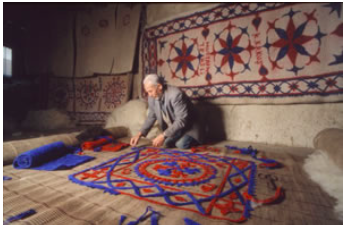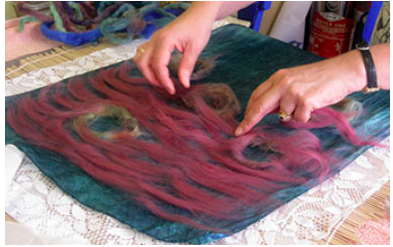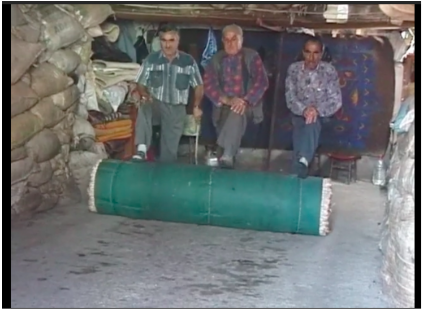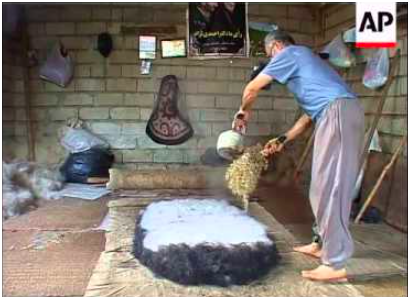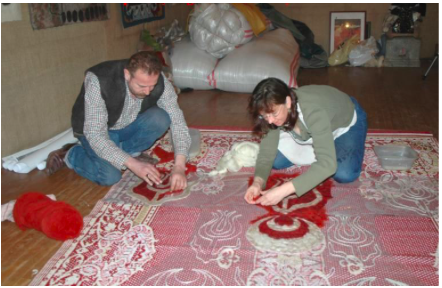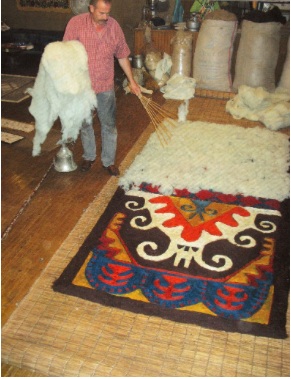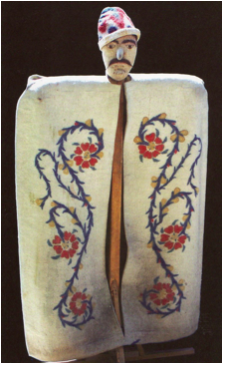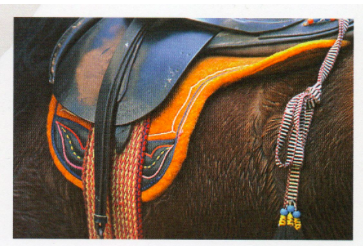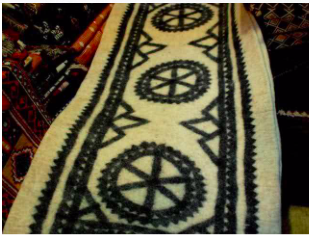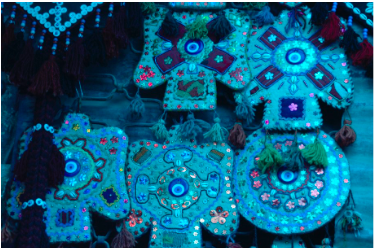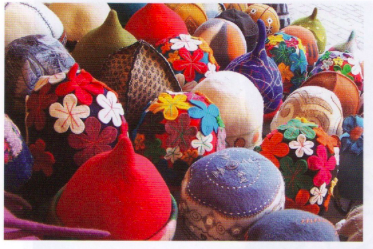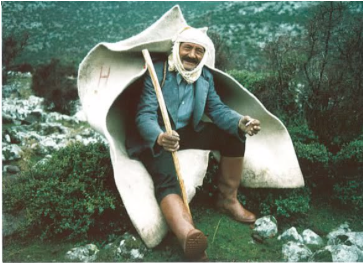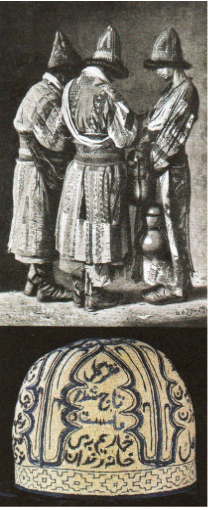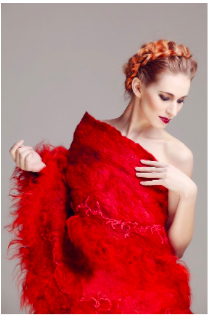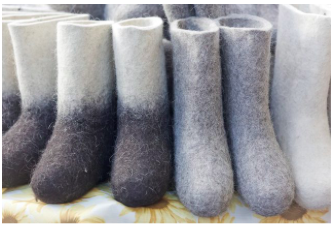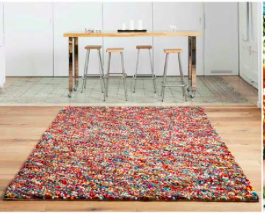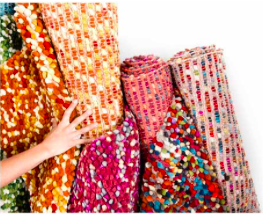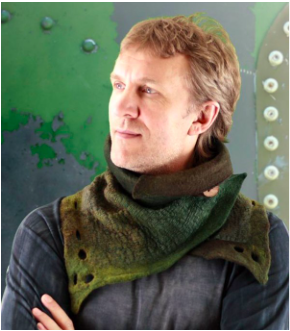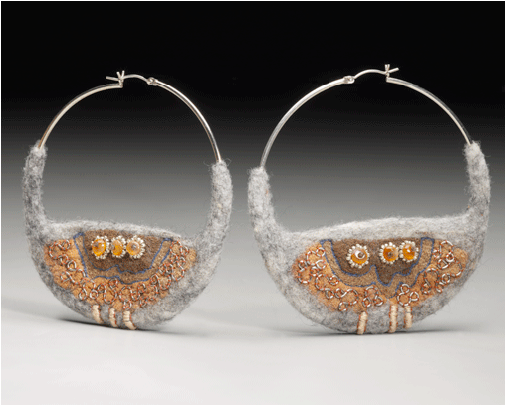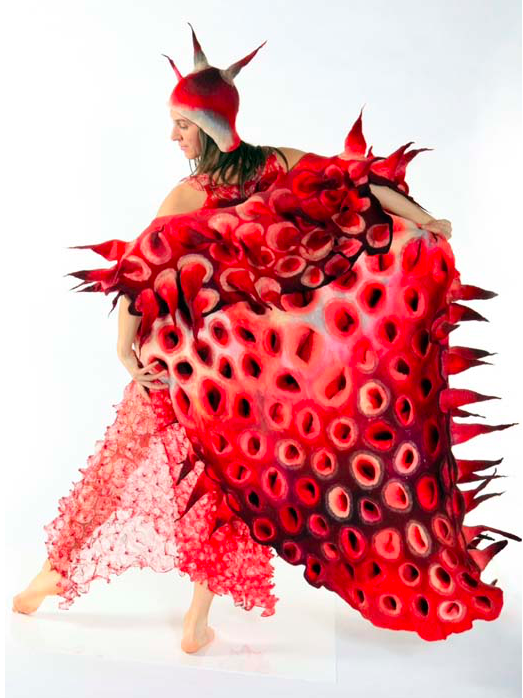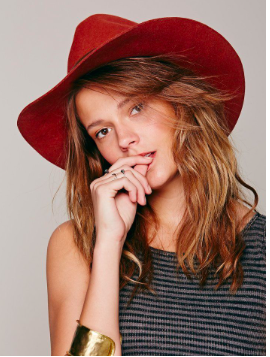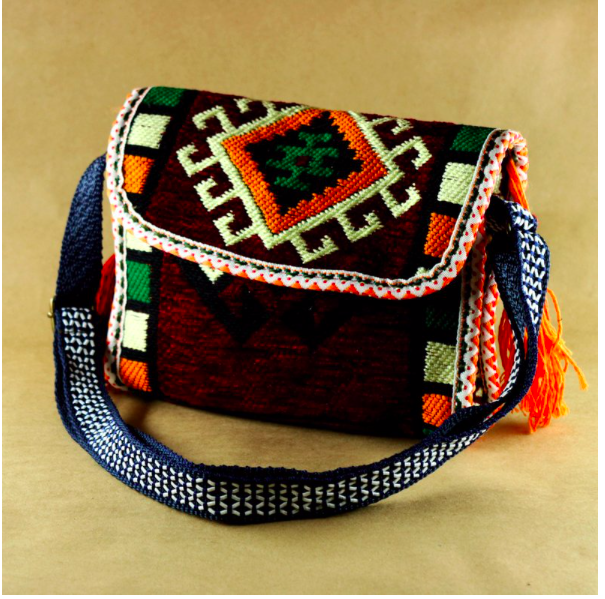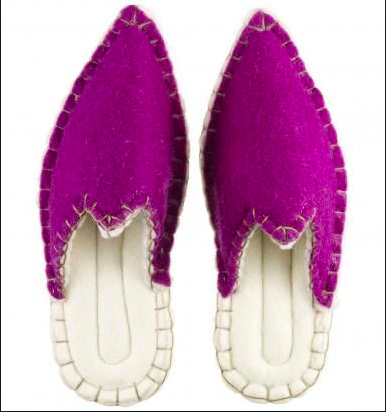The Technique
What process was/is used to make the design in general?
The process of felt-making is amongst one of the oldest and most basic forms of crafting textiles, but can be very tedious as done by hand in Turkish nomadic tribes. The sheep used for wool are sheared twice a year to ensure the fibers are long enough to mat together and entangle in the process. The raw wool is hand sorted and combed to remove unwanted materials, and hand dyed using natural resources in their surroundings. The wool is then beaten with a wooden device such as a bow or arrow, and is now ready to be made into felt. If a design is to be incorporated in, twisted and dyed pieces of wool are laid in desired patterns onto a flexible mat, typically made from sticks or twigs tied together. Next a solid, evenly laid layer of wool is placed atop the design on the mat and leveled off with a baton or rod made from wood. The felt-maker would then take water and sprinkle it all over the top layer, and using the mat would roll the wool up very tightly and begin the “crimping” process. This is a form of applying pressure over and over again to the roll to make sure the fibers interlock and eventually bind together permanently. Once the roll is dry, the felt product is ready to be used in tent making, clothing, or to be sold in markets.
Is it surface, structural, or a combination?
Felting is a structural design created by the permanent bonding of the wool fibers through layering, wetting, pressing, and drying.
What materials were/are used for the design?
While most Turkish felt-makers used sheep wool as their primary material, the hair of camel, goat, horse, and cattle are also known to be used in felting. Uniquely, wool is the only fiber to have the scaly structure that allows the fibers to mat together then re-attach permanently into the strong material that felt is.
Who did the work?
In Turkish nomadic society, everyone took part in providing means necessary to produce the felt material that became a culture within the tribes. Men often were the ones to shear the sheep, lay the wool, roll it up, beat it, and adding finishing touches to ensure the pieces are well bound and ready to be used or traded in markets for other goods. The fathers would more than likely bring their sons along the way to learn the technique and to learn how to sell their hand-designed wool felt carpets. While women were the homemakers, they took part in combing, separating, and dyeing the fresh wool, then also were the ones to sew the tents and saddlebags together. In extra time and spare wool, a women in these tribes would create smaller handicrafts they could also trade in markets. Children would help by tending to goats and sheep owned by the family, while shepherds kept the majority of sheep within the tribes. In some ways, the sheep were a lifeline for the Turkish nomads, which is why such a large part of their communities are involved in the process.
What was/is the purpose of the textile with this surface design?
The availability of felt to the nomadic people in Turkey was vital to their everyday lives and longevity of their survival. Their tents were made either from wool or from goat hair, and because felt is so flexible, while strong, it is easily compactable making it possible for them to carry their homes with them. The longer they could keep a home, the more excess wool they could have to create carpets and crafts to trade in markets. Other important uses for the Turkish people were the gear they created for shepherds; they made ponchos and umbrella-like devices that could shield them in the colder nights and keep them dry in the morning dews and showers. Felt is also seen throughout all of the Turkish clothing, as their culture is centered around it.
Is the technique still being carried out today by the culture? Do they still practice the technique, teach it, and produce objects with the technique?
While very few artists of traditional Turkish felting exist today, a handful of them actually offer workshops that demonstrate and teach the technique. Those who attend are given an opportunity to travel to Istanbul or Central Asia to visit nomadic tribes where they can gain knowledge about the culture and take home a piece they make themselves there in the villages.
Popular Culture Today
How is this surface design or structural design or combination produced today?
This combination design is produced in a variety of forms today, consisting of decorations and jewelry. Although felt is still produced today it is at a very low rate. When textile machines gained popularity, the production of felting decreased because it is produced primarily through the traditional processes. The designs still has the same felt texture, however they look very different. Designs today are much more vibrant, using bold bright colors. But overall the process of making felt is the same. It is not a simple job, but one that requires lots of skill and patience. The process begins by beating wool and then soaking it in water. After this it is pounded repeatedly until it formed the texture of felt.
Has the visual of the surface or structural design been used in material culture production today in popular culture or the fashion world?
Yes, felting has been used often in the fashion world. This design has been used in shoes, clothes, jewelry, and even bags. This is very evident throughout our pictures. One of our images is a costume created by contemporary felt designer Marjolein Dallinga. She is known for creating pieces of wearable art inspired by both grotesque yet whimsical creatures. Her designs have also been featured in Cirque du Soleil for both costumes and set designs. This exact piece is a wearable art piece that is meant to be a representation of skin inside out. Another image we have is of a pair of felt earrings. These earrings were designed by Lisa Klakulak. Her felt earrings are very exquisite and use only natural dyes from several products that were used before the production of synthetic dye. Our last image is a cosmetic bag created by an artist on etsy. This bag is handmade out of a traditional turkish felt carpet rug.
Is it copied or used as inspiration?
Many felt designers use traditional Turkish designs as inspiration rather than just copying older designs. But they create new unique designs that haven’t been seen before. Using brighter colors, interesting patterns, and different materials these new designs are formed. A good example of this would be the image of the cosmetic bag. The designer took a traditional item and recreated it a complete new innovative way.
What materials are used in the production?
Several different materials have been used in the production of felt designs, including a combination of felt with silk, wool fibers, as well as denim. The Ottoman cutting technique kaat’i allows the felt to take on a new form.
Where can it be purchased?
Turkish felt can be purchased online on site such as mood fabrics.
Who is producing it?
In today’s society felt is produced primarily through industrial methods. However many designers prefer using the traditional methods for felt making. Because of this, these designers work with dedicated men or felt masters you have devoted several years to felt making. There are very few felt makers left. The remaining felt makers can be found in the Turkish provinces as Afyon, Sanliurfa, Konya, Balikesir, Izmir, Kars, and Erzurum.
How much does it cost?
It can found for around $30.
Legal/Moral Issues
END
Has the culture group who produced the technique you researched given permission for the use of their work with the examples discussed in Part II?
The art of felting has been and continues to be, used all around the world. Felting in one of the oldest crafts, dating back to the 4th and 5th century BC. Felting was used all around Europe and Asia, and in Turkey too. Many cultures have different origins of how felting originated. There are no patents or exclusive rights on Turkish felting, so designers do not need permission to use the work of Turkish felting in their own designs. Felting is still used today and is public domain, so there is unlimited and unrestricted access to this art.
Discuss the laws that govern cultural intellectual property in the country where the culture resides.
Turkey started the necessary studies in 1995 to build a modern intellectual property rights system. The steps taken by Turkey achieved significant results and embodied in various laws, decree-laws, and regulations. But the history of intellectual and industrial property law in Turkey dates back to the Ottoman Empire era. In the Ahi Culture, guilds that develop a new product or innovation deserve a monopoly right for their product or innovation. The copyright concept became apart of the Turkish legal system in 1850. Several regulations and ordinances that have contributed to the protection of intellectual property have been put into force since then.
Turkey established the Turkish Patent Institute that has financial and administrative autonomy. It was founded in order to contribute to the technological development of Turkey, creating an environment free of competition and ensuring research and development activities. Within this institute, Turkish industrial property rights are now registered and certified. Turkey also became a member of several international organizations to make national legislation amendments more parallel with international legislation. In 1925, Turkey signed the “Paris Convention for the Protection of Industrial Property” and attended the “World Intellectual Property Organization” in 1976 in order to take the necessary steps towards the integration of the protection of intellectual and industrial property rights.
What laws in the US govern cultural intellectual property?
Article 1, Section 8 of the US Constitution gives Congress authority to govern cultural intellectual property. Congress grants authors and inventors exclusive rights to their creation. Section 8 gives the power to regulate interstate and foreign commerce. Intellectual property laws passed are administered by two government agencies, the US Patent and Trademark Office, and the US Copyright Office.
Patents are also very important in intellectual property. Patents give the inventory or designer the right to use their product in the marketplace, or they are allowed to make a profit by transferring that right to someone else. Most patent rights, depending on the type of invention, are valid for up to twenty years. There are also trademarks, that protect symbols, slogans, and names that are used to identify goods and services.
Is the design considered sacred and should not be reproduced because of its sacred nature?
Felting in Turkey is, and has been, used for many different purposes. The Turkmens traditionally lived in tents made of felt. Various areas of Turkey use felting for types of clothing. Turkish provinces as Afyon, Sanliurfa, Konya, Balikesir, Izmir, Kars and Erzurum have an interesting product that is a stiff, felt cloak worn by shepherds. The province of Erzurum wore red caps made of felt in the villages, and the neighboring province wore Kirklareli, men wear maroon felt fezzes. The most famous felt garment is the sikke, tall conical caps, that were worn by Mevlevi dervishes. Although Turkey uses felt to represent certain social contexts, there is no sacred or religious affiliation to keep it from being reproduced.
Is the technique/visual representation of the culture’s work considered public domain?
Public domain means works are not restricted by copyright, and do not require a license or fee to use. Public domain status allows for unrestricted and unlimited access and creativity. There are different categories of works that qualify as public domain. Titles, names, familiar symbols, and short phrases or slogans are public domain because they are not copyrightable. The same applies for ideas and facts, processes and systems, and government works or documents. One way works can be part of the public domain is when the creators assign their works to the public domain, then there are works that are part of the public domain because the copyright on them as expired.
Felting is done all over the world, including Turkey. There is no type of copyright or patent on the technique or visual representation of felting, so it is part of the public domain. Felting is a big part of society in Turkey, and is used by many weavers all around the country.
